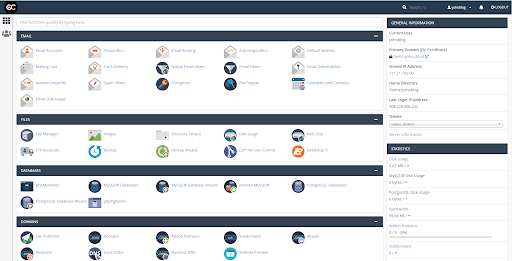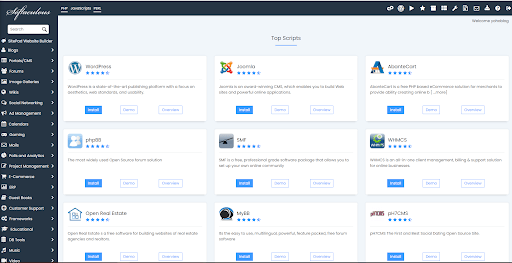Table of Contents
Introduction
cPanel is a control panel for web hosting running on Linux that provides a graphical user interface (GUI) equipped with many features to automate the hosting process. It is a premium software, which is developed in Perl by a private company, cPanel Inc.
Control panels are one of the most popular tools around the world. Cpanel is the back end of your website, where you can manage the DNS of your website, Addon domains, security settings, etc. The control panel lets you build websites, manage domains, organize files, codes, create email accounts, and much more.
Customers who purchase hosting from Yoho.Cloud receive cPanel as standard control panel.
The below snapshot shows how Cpanel looks after you logged in.

With cPanel hosting, you will get so many options like free SSL, auto WordPress installer, free backup on hosting. There are so many options or functions related to your domain in Cpanel that you can manage. A user interface may vary from one hosting provider to another, however, the features provided in cPanel are mostly common. Although some modules may vary, there are the most common modules found in cPanel, and it’s easy to use too.
Get familiar with the most common and important cPanel modules, which we will discuss below.
File Manager
File Manager in cPanel provides you with quick file management options. With it, you no longer need to use FTP for your sites. This interface allows you to create, upload, modify or remove your files. Moreover, the user can move files to Trash and then recover them later to be retrieved later if necessary.
From the Files section, click on File Manager.

Then a new window will open like below:

Here, you will get many options to manage your files, such as creating a file, folder, search a file, and many more.
Important: − In cPanel, there is a folder named public_html where all the files of websites are visible from the frontend of your website are stored. The file names Index.html or index.php are fetched first when the user visits your website via URL.
Below are the options that you can use File Manager for:
- Search a File
- Create a File
- Create Folder
- Copy Files or Folders
- Move Files or Folders
- Uploading a File
- File Upload
- Download a File
- Delete a File or Folder
- Rename a File or Folder
- Editing text files – Text Editor
- Edit codes – Code Editor
- Extract a File
- Compress a File or Folder
- View a File
Note − cPanel File Manager can only extract files in Zip, GZip, or BZip2 formats.
You can perform the above tasks from cPanel easily, learn how to manage your website’s files from File Manager through cPanel.
Moreover, in this FILES section, you can manage all your images, disk usage, FTP accounts, and backup your files.
EMAIL Hosting
This interface allows you to create and manage your domain’s email accounts. Here, you can set up a domain-based email address, configure your mail application, change your password, and access webmail directly.
The below snapshot is of the Email interface in cPanel.

Email interface in cPanel includes the following common components:
- Manage Email Accounts: Create an Email Address, Delete an Email Account, Check Email
- Auto Configuration
- Manual Settings
- Email Filters, Spam Filters
DATABASES
In cPanel, the Databases hosting are where all your contents, posts, and many more crucial data related to your website are stored. All your domain, subdomains data are stored in it.

Here you can manage the following modules:
- phpMyAdmin
- MySQL Database
- MySQL Database Wizard
- Create a New Database
- Add a Database User
- Modifying a Database
- Check a Database
- Repair a Database
DOMAINS
A domain is a physical IP address that directs you to a particular website. A domain name consists of two components, i.e., website name and domain name extension.
For example, yohocloud.com, here yohocloud is a website name, and .com is a domain name extension.
Subdomains are domains linked with a primary domain but might or might not contain a similar type of content.
For example, blog.yohocloud.com, here yohocloud.com is the primary domain, and blog.yohocloud.com is a subdomain under the main domain.
Using subdomain, you can create a new website free of cost. You can create as many subdomains as you want through cPanel.
In cPanel, the DOMAINS interface will offer you many options to manage all your domains, create domain and subdomains, add more domains, and many more.
Below are the functions that you can do in the DOMAINS interface of cPanel:

- Create a Subdomain
- Add Domains
- Manage Redirection
- FTP Account
- Remove an Addon Domain.
SOFTWARE
In cPanel, the Software interface deals with easy and simple to use applications and software which make your website work convenient. It includes plugins and easy-to-go installers.

Below are the modules found in the SOFTWARE interface:
- Cloudflare
- Softaculous Apps Installer
- Optimize Website
- Application Manager
- WordPress Manager by Softaculous
- MultiPHP Manager
Among all, the most used module here is Softaculous Apps Installer. If you are using CMS to build your website, with Softaculous Apps Installer, you can easily install scripts you are using.
Below snapshots shows you the tops Scripts that you can easily install with Softaculous.
There is no doubt that the most popular CMS used by the mass population is WordPress. You can easily install WordPress using Softaculous Apps Installer. If you are not familiar with this installer, learn how to install WordPress with Softaculous and other CMS installations too.

Therefore, Cpanel is one of the most used web hosting control panels to manage everything related to domain and server. Make sure you are using a domain with SSL whenever hosting a website. cPanel offers you a free SSL on hosting. Learn about how to enable SSL if you are using a hosting domain without SSL.
Thus, if you are planning to build a website, get a cheap cPanel hosting in Nepal.




1 Comment